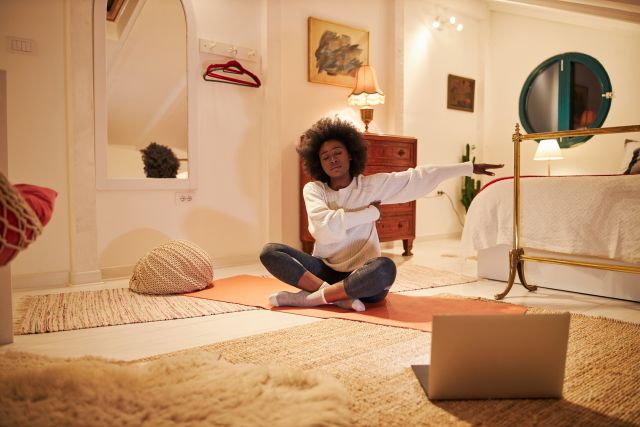If you have idiopathic hypersomnia (IH), you know how difficult it can be to follow a typical routine. IH is a sleep disorder that causes excessive daytime sleepiness.
While the disorder may cause you to sleep for 10 hours or more at night, you don't wake up feeling well-rested. To add to the frustration, daytime naps—even long ones—aren't refreshing, either.
There are treatment options for IH, including medications. But when you're first diagnosed, your healthcare provider will typically start by trying to help you regularize your nighttime and daytime sleep. This is often done through behavioral interventions like Cognitive Behavioral Therapy (CBT).
This may involve setting up a calming nighttime routine before bed, and this routine may include stretching.
Benefits of stretching before bed
Although it can be tempting to just fall into bed at night when you're tired, stretching has a number of benefits. First, it gives your body a chance to unwind physically from the day, which in turn can help to relax your mind.
Second, stretches help to relax your muscles, so you're able to rest more comfortably at night. Stretching can also improve blood flow, which improves your sleep quality. In this way, it can help your body rejuvenate itself more while you're asleep.
Going to bed and waking at the same time each night and day can be beneficial for people with sleep disorders. When done regularly, stretching can help signal to your body that it’s the proper time to wind down for sleep. It's good to stretch about 30 minutes to an hour before bedtime, so you won't be inclined to skip it because you're too tired.
The Best Types of Stretching
You might start by doing some deep breathing. If you're feeling stressed or anxious, do this for a few minutes. Standing up, you can do neck stretches, chest stretches, and quad stretches. Lying on your back, you can do poses such as putting your leg straight up and pulling the back of your thigh to stretch your hamstring, or you can bring one knee into your chest at a time. You can also lie on your back and send both your legs in one direction for a twist. Gentle yoga poses such as cat-cow and child's pose can also be good options.
Stretching mistakes to avoid
In general, there isn’t a “wrong” way to stretch before bed, provided that you aren’t pushing yourself too much. It’s fine to feel some gentle discomfort from the stretch, but you shouldn’t be in pain.
In addition, you don’t want to do anything too high-energy before bed. Don’t be tempted to go from stretching into jumping jacks or another active move.
Bedtime stretches to try
It can take a few tries to find a routine you like. It’s best to start small, with a 5-to-10-minute routine.
With that in mind, here is a short routine to get you started. If you hold each pose for 30 to 60 seconds, it should take five minutes or less.
- Child’s pose: Kneel on the floor with your knees hip-width apart and your feet together. Put your forehead on the floor, reach forward and place your hands on the floor in front of you, and push your butt toward your heels. This should lengthen your neck and spine as you breathe in and out.
- Cat-cow: Move onto your hands and knees, with your hands under your shoulders and your knees under your hips. Arch your back up and tuck in your tailbone (cat pose), and then let your lower back sag down, rotating your tailbone and neck upwards (cow pose). Repeat this movement slowly for 30 to 60 seconds.
- Knee to chest: Roll onto your back with both legs extended. Pull one knee into your chest, with the other leg still extended. Hold for 30 seconds and then repeat on the other side.
- Supine hamstring stretch: Still on your back, extend both legs out. Send one leg straight up so it’s at a 90-degree angle (your leg and back make an L shape). Hold onto the back of your thigh with both hands and pull the leg toward you gently. Hold for 30 seconds and then repeat on the other side.
- Supine twist: Lie on your back, extend your left arm straight out, and look to your left. Pull your legs up to your chest and then extend them both to the right, so your legs and arms are in opposite directions. Hold for 30 seconds, then repeat the twist on the other side.
Stretching is a soothing, healthy way to prime your body for restful sleep at bedtime, so you can feel your best with IH.






